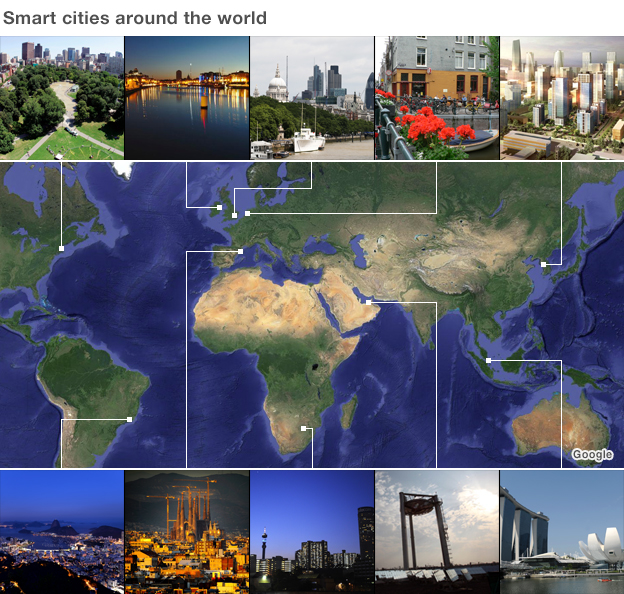Tomorrow's cities: Do you want to live in a smart city?
- Published
Boston, USA
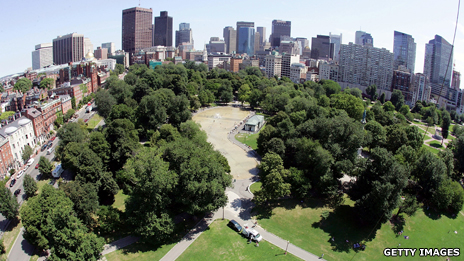
Boston is wired with a system called ShotSpotter which uses acoustic sensors to detect and pinpoint the location of gunshots. The city also has 222 sensors to detect biological weapons.
Equipment on buildings tracks greenhouse gas emissions while analytical software helps predict maintenance needs in parts of the sewer system.
The mayor has set up an Office of New Urban Mechanics to better connect citizens to city services and encourage people to contribute to community planning through a 3D game.
Rio de Janeiro, Brazil
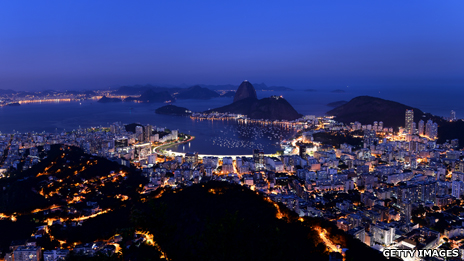
In 2010, city mayor Eduardo Paes tasked IBM with creating a city-wide operation centre which connects all the city's 30 agencies, from transport to the emergency services. It means that officials from across the city can now collaborate to manage the movement of traffic and public transportation systems, while also ensuring that power and water supplies work more efficiently.
A coordinated response can be rolled out in the event of a crisis, such as collapsing building. Transport systems can be shut down, emergency services mobilised and gas supplies can be cut off, while citizens can be informed of alternative routes via Twitter.
Dublin, Ireland
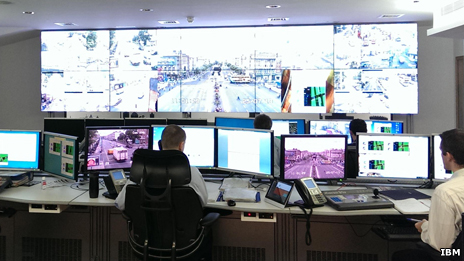
The city is used as a testbed for IBM which is working with the council to collect and analyse traffic data in an effort to ease congestion.
Journey information is released and updated every minute and residents can go online to find the quickest route to their destination. A digital map of the city is being built, overlaid with the real-time postion of buses.
The city is also experimenting with open data, creating some innovative apps such as ParkYa which uses live traffic data to direct people to parking spaces.
London, UK
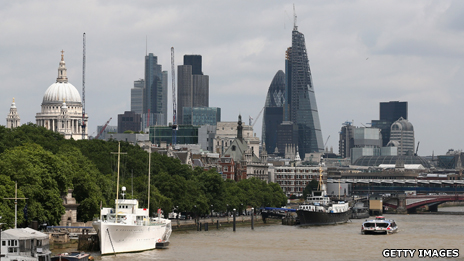
London already has an envied smart transport system, from the congestion charge to the Oystercard which allows people to pay for travel on tubes, trains and buses via a smart card.
In the Mayor of London's office a wall of iPads feeds a constant stream of data about how the city is performing, from what is trending on Twitter, to how happy the city is as well as measures of pollution, usage of the city-wide bike-sharing scheme, river levels and Tube information.
Intel has funded smart city research at London's Imperial College and University College. Meanwhile Cisco has set up a Future Cities centre in Shoreditch and Living PlanIT is using the Greenwich peninsula as a test-bed for its urban operating system.
Barcelona, Spain
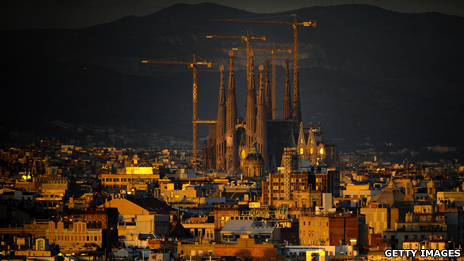
Barcelona city council's chief information officer, Manel Sanroma, made the bold statement last year that the cities of the future may become more powerful than nation states. Barcelona is determined to be one of the leaders: It has created more efficient bus routes, streamlined rubbish collections using sensors, introduced smart street lights and is developing contactless payments across all public transport.
A city operating system which will bring all systems together in one place is also being developed.
Amsterdam, Netherlands
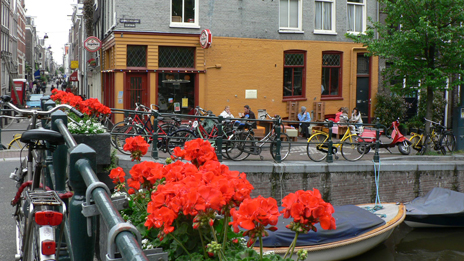
The city is doing lots of work with opening up public data and a range of apps have been created, such as Bike Like a Local, an app devised for tourists to help them to cycle across the city; Appening Amsterdam, a device to find out where to go on a night out; and Drive Carefully, an app which alerts you if you are driving near a school.
The Amsterdam Smart City website is full of schemes that have been adopted. It includes a platform that allows neighbours and friends to safely rent their cars to each other to a testbed sustainable neighbourhood where more than 500 homes were provided with smart meters that should enable the residents to become more aware of their energy use.
Johannesburg, South Africa
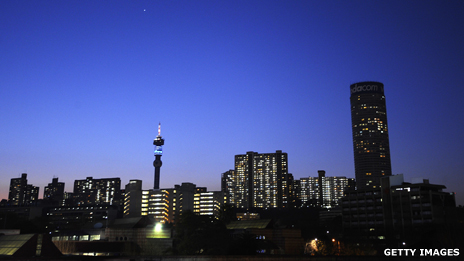
One of Africa's first smart cities, Johannesburg now boosts a super-fast fibre optic network which is the envy of other African countries.
The City of Jo'burg Broadband Project went live in July with a fibre optic network that covers all regions of the city with an impressive 1.2Tb (terabit) capacity.
It is also planning to introduce smart metering of electricity and water and build an intelligence centre for public safety.
City mayor Mpho Parks Tau said he wants the city to "become smart in all aspects."
Masdar, UAE
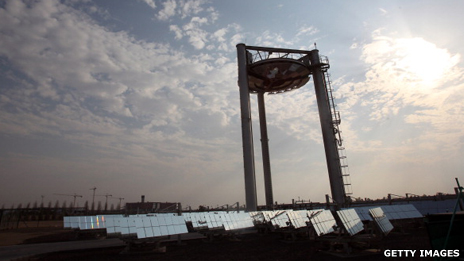
Masdar, which means "source" in Arabic, is a city that stands in the middle of the desert of Abu Dhabi in the United Arab Emirates.
It is designed to be one of the most sustainable on the planet. With a solar power station at its heart and wind farms providing energy for it, it aims to be carbon free.
The city is built on a raised platform to allow its "digital plumbers" easy access to the system of advanced technologies that run it.
It is pedestrian-friendly and entirely car-free, although the city is experimenting with a network of electric driverless podcars.
Singapore City
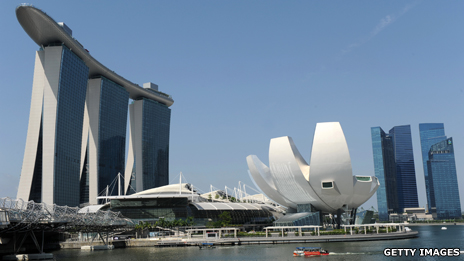
Singapore is working with MIT's Senseable Cities Lab to find new ways of using the real-time data generated in the city.
It is using mobile phone data to find ways to improve the city's public transport and data analysis has already thrown up some anomalies, such as the fact that people use more public transport in the morning compared with the evening rush hour.
The data generated is available on an open platform and has already resulted in some innovative apps, such as weather forecasts given 10 minutes in advance, which can direct taxi drivers to the areas of the city where it will be raining.
Songdo, South Korea
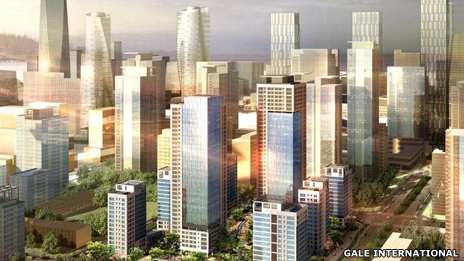
The $35bn (£23bn) project, located on reclaimed land near the Yellow Sea, was widely considered to be a model for smart cities around the globe when it was started in 2005.
Also known as a ubiquitous city or U-city, Songdo's information systems are all linked to each other. It has led critics to dub it a "city in a box" - a showcase for technology but not necessarily ideal for people.
Every home has a telepresence system. As well as allowing users to control heating and locks, it offers video conferencing and is intended as a way to deliver education, health care and government services.
The city is due for completion in 2015, by which time it will be home to 65,000 people and 300,000 workers.
How do you fancy living in a city with which you can interact? A city that acts more like a living organism, a city that can respond to your needs.
Around the world such cities are already being built, from Masdar in Abu Dhabi to Songdo in South Korea. Now the chaotic city near you may be in line for a makeover.
In the future everything in a city, from the electricity grid, to the sewer pipes to roads, buildings and cars will be connected to the network. Buildings will turn off the lights for you, self-driving cars will find you that sought-after parking space, even the rubbish bins will be smart.
But how do we get to this smarter future. Who will be monitoring and controlling the sensors that will increasingly be on every building, lamp-post and pipe in the city?
And is it a future we even want?
Technology firms such as IBM, Siemens, Microsoft, Intel and Cisco are busy selling their software to solve a range of city problems, from water leaks to air pollution to traffic congestion.
In Singapore, Stockholm and California, IBM is gathering traffic data and running it via algorithms to predict where a traffic jam will occur an hour before it has happened.
Meanwhile in Rio, it has built a Nasa-style control room where banks of screens suck up data from sensors and cameras located around the city.
In total IBM has some 2,500 smarter cities projects around the world and has even trademarked the term "smarter cities".
But when, at a recent smart cities event that IBM hosted, one of its engineers joked that the company "tends to look at the pipes and then people come along and destroy all our nice optimised systems", it summed up the issue that some have with the corporate-led approach to city management.
"Some people want to fine tune a city like you do a race car but they are leaving citizens out of the process," said Anthony Townsend, director of the Institute of the Future and author of Smart Cities: Big Data, Civic Hackers, and the Quest for a New Utopia.
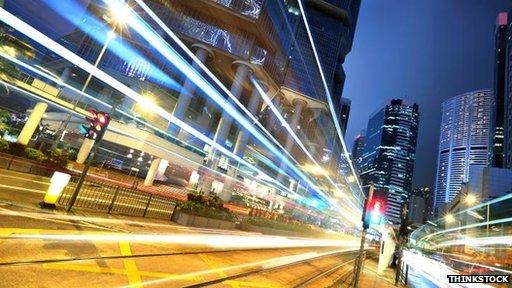
Smart cities will need smart networks into which everything is hooked
IBM argues that it does get citizens involved in its smart city projects. In Dublin it has worked with the city council to open up the vast amounts of data it has, which has led to clever little apps such as ParkYa which uses traffic data to find people the best parking space in the city.
And in the US city of Dubuque, Iowa, where it is developing smart water meters, it has offered the data to citizens via a community portal, so that individuals can see their water usage and even compare it with that of their neighbours.
But there is a sense that for the firm, cities are a problem just waiting to be solved.
"We need to build cities that adapt to the needs of [their] citizens but previously it was not possible because there was not enough information," says Dr Lisa Amini, director of IBM Research.
She makes the comparison between the "assets" of cities, such as street lights, traffic, water pipes and those of large corporations, for which IBM's systems were originally designed.
Mr Townsend is not convinced that the technology can so easily be transferred.
"Government doesn't make decisions like businesses do. Citizens are not consumers," he says.
China is busy building dozens of new cities and is starting to adopt huge control rooms like the one IBM has created in Rio.
It worries Mr Townsend.
"The control room in Rio was created by a progressive mayor but what if the bad guys get in? Are we creating capabilities that can be misused?" he asks.
Citizen network
There is another chapter in the smart city story - and this one is being written by citizens, who are using apps, DIY sensors, smartphones and the web to solve the city problems that matter to them.
Don't Flush Me is a neat little DIY sensor and app which is single-handedly helping to solve one of New York's biggest water issues.
Every time there is heavy rain in the city, raw sewage is pumped into the harbour, at a rate of 27 billion gallons each year.
Using an Arduino processor, a sensor which measures water levels in the sewer overflows and a smart phone app, Don't Flush Me lets people know when it is 'safe to flush'.
Meanwhile Egg, a community-led sensor network, is alerting people to an often hidden problem in our cities.
Researchers estimate that two million people die each year as a result of air pollution and as cities get more over-crowded, the problem is likely to get worse.
Egg is compiling data about air quality by selling cheap sensor which people put outside their homes where they collect readings of green gases, nitrogen oxide (NO2) and carbon monoxide (CO).
The data is sent to the internet where it is integrated on a map to show pollution levels around the world.
Getting citizens involved in the process of improving cities is crucial, thinks Andrew Hudson-Smith, director of the Centre for Advanced Spatial Analysis at University College, London.
He and his team have created a city dashboard as part of plans to make London smarter.
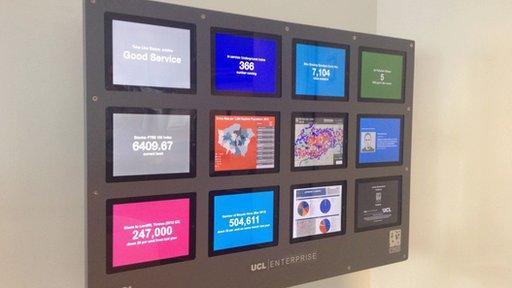
The iPad wall is a cheaper alternative to Rio's command room
Like Rio's control room, the dashboard collates data such as pollution, weather and river levels.
But it also looks at some things that Rio doesn't - such as what is trending on Twitter and how happy the city is.
A version of the dashboard is hooked up on a wall of iPads in the office of the Mayor of London, Boris Johnson.
But importantly, there is also a version available on the web.
"The public has the same information as the policy-makers and that has the potential to be incredibly powerful," he says.
"A lot of the big firms are looking at the control room model, but it is backward thinking.
"Why put the technology in one room when you can put it in the hands of everyone?" he asks.
Services under pressure
There is little doubt that cities have to get smarter.

By 2050 it is estimated that 75% of the world's population will live in cities, putting pressure on the transport network, the emergency services and the utilities that are already stretched to capacity.
The reality is that most smart city projects are currently pretty small scale - creating tech hubs or green areas of the city, experimenting with smart electricity grids or introducing electric buses or bike-sharing schemes.
As Dr Hudson-Smith puts it, "there is a lot of buzz around smart cities but there is no technology out there that is actually changing people's lives."
But he also thinks we are at a tipping point and in five years time he predicts "things will be incredibly smart".
At that point, the data infrastructure of our cities is going to become as important as the train and roads are now.
Whether such data is controlled by big business or citizens is not yet clear, but it is worth remembering what cities were originally designed for, says Dan Hill, chief executive of research firm Fabrica.
"We don't make cities to be efficient, we make cities for culture, commerce, community - all of which are very inefficient," he said.
In the rush to make them perform better, we could be missing their greatest asset.
"It is going to be smart citizens that make smart cities," he said.
- Published21 February 2013
- Published22 February 2013
